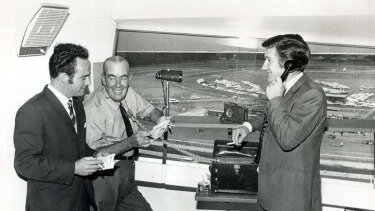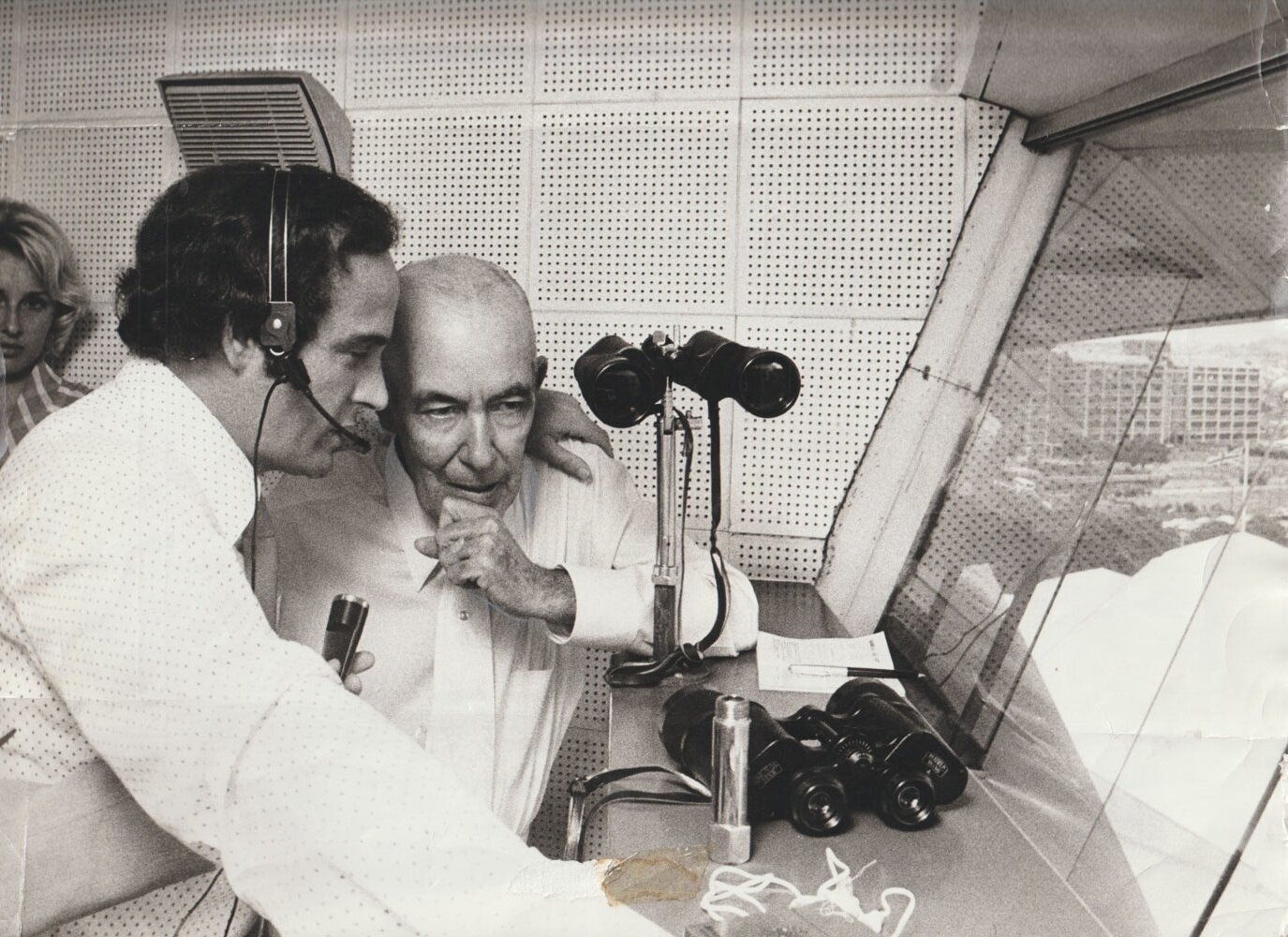THE DAY KEN HOWARD PUT AWAY THE GLASSES!
REMEMBERING THE MAN WHO PUT SHOW BUSINESS INTO RACE CALLING.
If Ken Howard was feeling emotional when he walked into the 2GB broadcasting box at Randwick on December 31st 1973, he certainly wasn’t showing it.
At that early stage of the day it was business as usual. A big programme of racing awaited the broadcasting legend and he intended to finish the job before he allowed himself to be distracted by such a trifling matter as emotion. Mind you his work schedule had been lightened by two races at his own request. He insisted that both Ray Warren and I should each call a race later in the programme, which would allow him ample time to attend a special presentation ceremony downstairs.
This doyen of Australian callers removed his white fedora hat and flicked it with unerring accuracy towards a brass hook situated on the rear wall of the box. He’d been doing it for years and I never saw him miss the target. Ken loved his large collection of hats, most of which were supplied by his great friend Jim Marr who owned Vic Cooper’s Hat Store in the Wynyard Arcade.
He quickly claimed a second brass hook for his well tailored jacket. The maestro had chosen his outfit carefully for his final day in the role of Australia’s best known race caller. He loosened the knot of his silk tie as he strode to the front of the box, where he fixed his Zeiss binoculars to the swivel - something he’d done thousands of times over four decades.
The six months had passed quickly since Ken officially announced his impending retirement during a Rosehill race meeting. He calmly told his large national audience that the time had come for him to step back from a pretty intense working life. He nominated New Year’s Eve as the date of his last day behind the binoculars. To Ken it made good sense to see out the year of 1973 in its entirety - neat, uncomplicated and decisive. That’s the way he’d been doing things all of his professional life.
Ken was on his way to the broadcast box when this one was snapped in the Vista Room on the fifth floor of the defunct Queen Elizabeth Stand - 1969.
The media hadn’t started to make its presence felt as the legendary commentator prepared to call the opening race of the day. His concentration was unwavering as he described the Randwick Stakes won by the favourite Kronprinz with Kevin Langby in the saddle. Still not a hint of nerves.
He was unfazed as Kevin Langby made it a double on Rhyanidd in the Garden Island Hcp, and was really warming into it as he called Graham Horselman home on Venetian Star in the Putney Novice Hcp. Ken was waxing lyrical as the punters pal Kevin Langby made it a treble on Bazaari in the Chiswick Hcp, fourth race on the card.
By this stage of the day we’d had a couple of newspaper reporters pop in to get a few quotes from the legendary caller, but nobody envisaged the media contingent that would gather later in the day. Throughout the afternoon studio host Garth Cary had been broadcasting messages from old friends and work associates from years long gone - usually a sure fire way to trigger a lump in the throat. Still no nerves, still no emotion. This man was a rock.
Not long to go now, and the curtain would come down on a career that had brought the face and voice of Kenneth Percival Howard to a position of prominence enjoyed by few media identities in this country.
Apart from many unbroken years on radio, it should be remembered that Ken was a regular on TCN Channel 9 from its launch in 1956. Devoted racing man Sir Frank Packer insisted on racing content from the outset. I recall walking down Elizabeth St in Sydney with Ken one morning in the late 1960’s. People were stopping him for a chat, while others were yelling to attract his attention from the opposite side of the street. Perhaps the best indicator of his place in Australian society was the MBE (Order of the British Empire) awarded to him as far back as 1967. Sydney racing never had a better ambassador.
Ken was popular with sponsors in the early days at TCN 9. He did many live commercials including this one for Packard Shoes.
Sydney born Ken Howard had set his sights on a broadcasting career from the first time he heard pioneer caller Mick Ferry on the ABC in the late 1920’s. In 1936 he landed a job as a messenger boy with station 2SM and was given the additional duty of understudying race caller Reg McKenzie who introduced him to the public later that year. Ken made his race calling debut from an off course location at Moorefield. He told me later that the winner of that race El Senorita, was a specialist around the undulating Moorefield course.
Ken became the station’s chief caller when McKenzie decided to relinquish the role in favour of a career in journalism. Over the next few years he gained an enormous following as he developed a dramatic style of race calling never before heard in Australia. Broadcasting from awkward locations outside racecourse boundaries, he almost certainly took some poetic licence in his descriptions, but nobody cared. He brought the excitement of the track into thousands of living rooms, and listeners couldn’t get enough of it.
Despite some atrocious angles in that pre photo finish camera era, Ken’s opinion usually matched that of the official judge. A little bit of anticipation and perhaps a large degree of luck came into play, but he was usually right. The nickname “Magic Eye” was bestowed upon him in the late 1930’s and old friends were still addressing him by that pseudonym more than thirty years later. Whether it was by accident or design, Ken was to develop a cliche in his early years which would find its way into the vernacular. When confident about the likely result in a close finish he would say “you can bet London to a brick on” a particular horse will get the decision. He used that expression for the rest of his career and future generations would pick it up with no idea of its origins.
In a bizarre twist of fate, it was Ken’s incorrect opinion in a photo finish to the 1968 Epsom that caused a near riot in the interstate betting ring at Flemington. Ken plumped for the Victorian horse Joking which was beaten narrowly by Speed Of Sound. Early the following week intense pressure from the VRC saw Ken’s calls of Sydney races taken off the complete southern network. Not only had he lost London, but half of his audience went with it.
Back to 1940 when a tempting offer from station 3XY lured Ken to Melbourne as replacement caller to Harry Solomons. Here the legend grew. Still banned from an on course location, Howard called the races from some preposterous vantage points. He made the headlines on one occasion when he fell out of a tree at Pakenham, and he once infuriated officials at the same venue when he called the action from a hot-air balloon. In quiet moments years later he’d tell me stories about the things race clubs would do to stop radio broadcasts going to air.
Modern day callers in lavish broadcast boxes situated opposite the winning post, should spare the occasional thought for pioneers like Ken Howard and his contemporaries.
By the time the intrepid broadcaster returned to Sydney towards the end of WWII he was a legitimate superstar. He was one of 2UE’s headline acts right through to 1959, when he was successfully head hunted by 2GB. He and Clif Cary became a hugely popular duo right through into the early 1970’s. Imagine some of the memory flashbacks Ken would have experienced in the days leading up to his much publicised swansong on New Year’s Eve 1973.
Media people were popping into the box all day to grab a few words from Ken.
Race five was coming up, and it was time for Ken to put on his hat and coat and make his way downstairs. It wasn’t long before the AJC Chairman Sir Brian Crowley was introducing the legend to hundreds of racegoers who were four and five deep around the birdcage fence. Sir Brian capsulized Ken’s stellar career and the enormity of his contribution to the racing industry, before presenting him with a handsome memento of the occasion.
Ken’s response was brief but predictably appreciative. He thanked several people, with special acknowledgement of his wife Iris and his long time race day assistant George Breen. His final few words remain etched in the memories of those who heard them. In a matter of minutes he would be back on the moving footway which would take him to the broadcast boxes high up in the Queen Elizabeth Stand. “Ladies and gentlemen I’m about to board the movator to take the longest ride of my life.” Everybody knew exactly what he meant.
The presentation and the inevitable salutations had taken quite a while. By the time Ken made it back to the broadcast box, two races had been run. I had the pleasure of calling the Kingsgrove Encourage won by Starstruck ridden by present day trainer Allan Denham, while Ray Warren had broadcast the Palm Beach Hcp won fittingly by jockey John Duggan on Lord John.
Ken with John Tapp and Ray Warren in the Randwick broadcast box 1970.
Once again the fedora hat and sports jacket found their marks on the brass hooks and it was time for Ken to take his position behind the binoculars. This time he had to jostle his way through the kind of media scrum you’d expect to see at a Canberra press conference. Newspaper journalists, photographers and TV cameramen all contributed to the crush. I never did find out if Ken was aware of the size of the audience he was about to address.
His final call was to be heard on 2GB and its national network, while rival station 2UE and its network paid him the great compliment of taking a “split” of the call. The same applied to the ABC with its many overseas relays. It was also arranged for the broadcast of the race to be fed to the Randwick course broadcasting system. I’ll be surprised if a race broadcast anywhere in the world has ever been heard by a bigger audience. Nor has a commentator ever performed under such pressure.
There was one final test for Ken’s central nervous system. Garth Cary had arranged for his father Clif Cary to record the final cross to the doyen of all race callers. Still no reaction, still no emotion. With that familiar brassy voice ringing out over the famous Randwick speakers, the maestro prepared to bring down the curtain on a career that had endeared him to many generations of Australians.
By way of a final tribute the race was called the Farewell Welter. The call was flawless. Not a blemish, not a stumble. The winner was Riverina galloper Captain Royal ridden by Barry Bowditch. There was still a bit to do before the job was complete. A brief summary, margins, time, correct weight. And it wasn’t until every last detail had been broadcast that a crack finally appeared in the concrete wall the man had built around himself on that final day.
He suddenly grabbed my left wrist and I could feel his fingernails biting into my skin. He tried to say something but nothing came out. He called my name, removed his headset and placed it on my head. I looked around to see that he was quietly sobbing. It had to come eventually but he wouldn’t let it happen until his work was done. I tried to speak, but nothing came out. I crossed back to the studio until composure returned to the Randwick broadcast box. The boys back in Sussex St were battling to put two words together.
This was an emotional moment just after the great commentator had signed off for the last time.
Ken had planned his retirement meticulously. He owned a home with an ocean view at Nambucca Heads and couldn’t wait to settle down with his beloved Iris and as much fishing and lawn bowls as he wanted. He told me he’d never call another race, but once or twice he allowed himself to be talked into helping out when the Bowraville commentator was unavailable. I’m sure he loved it and you can imagine the delight of the locals.
I was listening to the 2GB breakfast programme one October day in 1976, when news came through that Ken Howard was dead. Less than three years after that unforgettable Randwick farewell, the great broadcaster had succumbed to cardiac arrest seven weeks short of his sixty third birthday. Reports of other health issues came to light some time after his passing.
He was on my mind for a long time. I was still using the broadcast boxes he’d occupied for many years on the four metropolitan courses.
I could feel his presence every time I fixed my binoculars onto the swivel before the start of a race meeting. I don’t recall ever telling him that I started listening to him at age ten. I don’t recall ever mentioning the fact that he was the whole reason I wanted to be a race caller. Because of Ken Howard I followed a dream which led me to the only career I ever wanted, and to a life revolving around horses.
Ken Howard you’ve got a lot to answer for!
Ken was sent to the UK to call Sir Ivor's Epsom Derby in 1968. While he was there he located a genuine "London brick".
(Banner image - This one was taken as the field rounded the hometurn in the Farewell Welter at Randwick 31/12/1973.)






